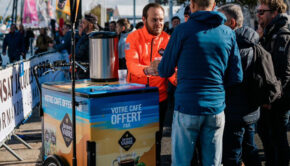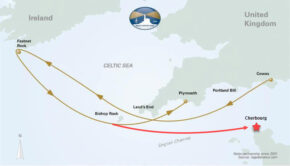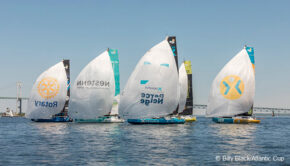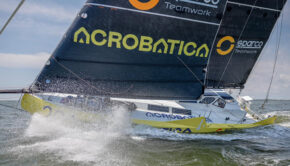Next Up: Transat Jacques Vabre
Published on August 20th, 2013
After much needed rest, pizza and a few beers, Brit Hannah Jenner & American Rob Windsor (Team 11th Hour Racing) look back on their Fastnet Race (they finished 8th among 18 Class 40s competing in the world’s oldest and largest offshore ocean race) and turn their attention towards the Transat Jacques Vabre which starts November 3.
On the morning of August 1st we sat down for coffee in the boat yard in Hamble, England for our first meeting as Team 11th Hour Racing. Rob and I had been away for much of July after our Trans Atlantic delivery, but now we were back and ready to get to work. We had ten days to prepare for the Fastnet Race and a big long job list to get through. As ever when you start on a project that begins in a boatyard you feel as if you are going backwards in the early stages. The deconstruction phase which for us involved dropping the rudders out of the boat, sanding the bottom and removing old unused electronics is a messy business.
It was during this phase that we discovered that what had looked like slight damage to the starboard rudder, probably caused by hitting something in the middle of the ocean, was actually a lot more serious. The rudder which was new at the beginning of the year had split clean open and would not be useable in the Fastnet Race. Fortunately we have a spare and on closer inspection by a boat builder, we discovered that the rudder had been constructed with large voids in it and never would have lasted for any length of time so better we discovered it when we did.
After five days of grubby boatyard work we put 11th Hour Racing back in the water and immediately had a team of graphics people working to brand us up. Although this was only phase one of the branding process, the boat looked great and a day later our new Musto team gear arrived so the crew looked just as smart as the boat. We had action packed days training working our way through our sail wardrobe and going through maneuvers to coordinate crew positions. By Saturday afternoon we were loaded with food, water and had our strategy for the race in place.
We woke on race start day to learn that Peter would not be able to race with us so the crew would be down to a team of four. Four is actually a great number to race with on a Class 40. For a boat that is set up predominantly for double handed sailing, much more than four people starts to get a little crowded and can slow things down. After passing through the security gate and checking in with the race committee we motored out to the start fueled with biodiesel in our tank.
At 1210 on Sunday 11th August we entered into our start sequence opting for a port tack start in the middle of the line away from the crowded pin end and avoiding the near collisions amongst the tightly packed Class 40 fleet. We got a good start being just about a boat length behind the line at the gun. The first stage of the race was a beat out of the solent short tacking up the mainland coast to stay out of foul tide. The four of us worked the boat well, trimming driving and moving the stack with every tack we made. The wind was shifty and gusting from 12 to 18 knots under large clouds and unfortunately about half way up the beat we got stuck the wrong side of the one of those clouds and it cost us a couple of places.
With 600 miles to go though the main aim in this stage of the race was to get out through the Needles Channel cleanly and in touch with the newer, faster boats. All was good until Rob went down below and immediately returned to announce that there was a large quantity of water sloshing around in the bilge. So as we sailed out of the Needles, a narrow stretch of water with land on one side and a shingles bank on the other, Rob and Sam sailed the boat while Nic and I (Hannah) bailed and sought out the cause of the water ingress.
We use water to help keep the boat flat instead of people. We can add just about 200 gallons of water to tanks on the windward side to help keep us flat. That is about 1600 pounds, just like having 8 of me (Rob) sitting on the rail. Anyway, that 200 gallons ended up on the floor in our living area while we were sailing out of the Solent. To put it mildly, that sucked. Pumping out the water was one thing, but we were only a few hours into a 3 day race. We got the problem solved but the damage was done. It took some of us away from the sailing which is the really important part of it all.
A few hours after we reached the English Chanel, we needed to fill the ballast tank again. I flipped the switch that turns it on but nothing happened. This is when the real mess began. Not being able to put ballast in would mean we would need to decrease sail area. I (Rob) couldn’t have this and neither could the rest of the crew. We worked out a way to put the ballast in using the bilge pump but it took 2 people to do it. One person on the pump and one holding the hose in the water off the back of the boat. It doesn’t sound too hard but I will try to explain. If you drive your car 10 miles an hour and stick your hand out the window with your palm facing the ground, you can sort of fly your hand through the air. If you point your fingers to the sky and palm towards the front of the car, your hand will be blown toward the back. Now try holding a hose in the water (it’s really cold here) and don’t fall off or get too wet. 20 minutes to fill both tanks! Not fun or fast. It took us totally out of our game because playing the ballast is a huge part of Class 40 sailing.
Still we are not quitters and we pushed on hard climbing up through the fleet and taking advantage of our upwind capabilities to reach 6th place as we crossed the Celtic Sea. We chose an alternative route to the nearest 40’s as we approached the rock but despite a less than favorable wind shift 5 miles from the Fastnet rock, we came flying in at 12 knots under spinnaker and pulled off an immaculately executed spinnaker snuff, solent out, ballast fill, gybe and drop maneuver right in front of the spectator boats and within a few meters of the rock. There was certainly no room for error there.
On our way back we had a fast ride under code zero which then became A2 as we fought to hold off Momentum Ocean Racing, the hydrogenerator whirring away to charge our batteries We passed within a few boat lengths of smaller boats still making their way out to the rock and slower boats that we overtook as we surfed past at 15-16 knots. We did make a mistake in going north of the traffic separation scheme off of the Scilly Isles but we chose that route to allow us to carry our spinnaker overnight to keep boat speeds high and fend off our nearest competitors. It would have worked had the breeze not gone soft as we turned the corner.
As we passed Lizard Point we gybed inshore but didn’t quite take it far enough inland and ended up in a zone of lighter breeze and lost out to Moonpalace and Momentum but it was not without a monumental effort from the team to get the best speeds out of the boat. It is very hard to stop frustration from interrupting focus in these situations but we did everything we could, eventually crossing the line in the dark squeezed between the lighthouse and a passing ship after an incredibly intense and close battle Forty Shades of Grey.
All in all, it was a good race. We learned some things about the boat and ourselves. We learned that when stuff breaks we can figure out a solution. We also learned that it takes an awful lot out of you to have these things go wrong, mentally and physically. While we are disappointed that we ended up in 8th place rather than 5th which is where we feel we should have been, the technical problems we encountered were a distraction that didn’t help us.
We didn’t have a whole lot of time to sort the boat before the Fastnet but we do have a lot of time before the TJV. We will be going over the systems with a fine toothed comb to make sure this doesn’t happen again. And ultimately it is better that we discover the issues now than when we are racing the 5,500 miles to Itaji in November. Team 11th Hour Racing








 We’ll keep your information safe.
We’ll keep your information safe.